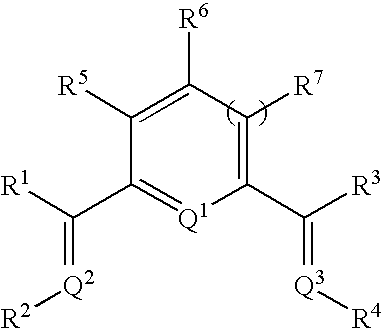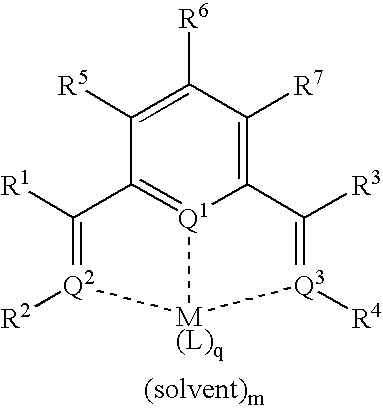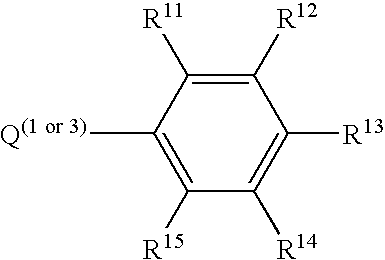Catalyst composition and olefin polymerization using same
a technology of catalyst composition and olefin, applied in the field of new metal complexes, can solve the problem that many catalyst systems are usually not very selectiv
- Summary
- Abstract
- Description
- Claims
- Application Information
AI Technical Summary
Benefits of technology
Problems solved by technology
Method used
Image
Examples
example 1
[0089]This example shows a typical preparation method of a tridentate ligand like 6-[1-{(2,6-dimethylphenyl)imino}ethyl]-2-acetylpyridine. 3.0 g (18.4 mmol) of 2,6-diacetylpyridine and 2.3 ml (18.7 mmol) of 2,6-dimethyl aniline were added to a flask with a stirbar and 20 ml of anhydrous methanol. Several drops of glacial acetic acid were added, and the reaction was heated with stirring for 3 days at 55° C. The reaction flask was then placed in a freezer at −20° C., resulting in the formation of yellow, needlelike crystals. These crystals were removed by filtration and washed with cold methanol (yield=1.15 g, 23.5%).
example 2
[0090]The following is one example of demonstrating how a chromium based complex—chromium(II) 6-[1-{(2,6-diisopropylphenyl)imino}ethyl]-2-acetylpyridine chloride (with THF) was prepared:
[0091]A sample of 1.0 gram of 6-[1-{(2,6-diisopropylphenyl)imino}ethyl]-2-acetylpyridine and 382 mg of chromium chloride (CrCl2, obtained from Aldrich Chemical Company) were transferred into a flask in a drybox under argon. Anhydrous tetrahyfuran (THF), about 50 ml, was added to this mixture. The mixture was stirred overnight under argon. The mixture was then allowed to stand for three days, followed by addition of about 100 ml of n-pentane. A grayish purple solid was isolated by filtration in air. The filtrate was green. The recovered solid was further washed with n-pentane and dried. Total yield was 1.237 grams (90% of theoretical yield).
[0092]This metal complex was used for the polymerization reaction Entry 9 and Entry 13 in TABLE I.
example 3
[0093]A similar method was used successfully to prepare a chromium(II) chloride complex containing 6-[1-{(2,6-dimethylphenyl)imino}ethyl]-2-acetylpyridine. The complex had a light purple color. The amount of tridentate ligand used was 267 mg and CrCl2, 120 mg was obtained from Strem Chemical Company.
[0094]This metal complex was used for the polymerization reaction Entry 8 in TABLE 1.
PUM
| Property | Measurement | Unit |
|---|---|---|
| purity | aaaaa | aaaaa |
| purity | aaaaa | aaaaa |
| yield | aaaaa | aaaaa |
Abstract
Description
Claims
Application Information
 Login to View More
Login to View More - R&D
- Intellectual Property
- Life Sciences
- Materials
- Tech Scout
- Unparalleled Data Quality
- Higher Quality Content
- 60% Fewer Hallucinations
Browse by: Latest US Patents, China's latest patents, Technical Efficacy Thesaurus, Application Domain, Technology Topic, Popular Technical Reports.
© 2025 PatSnap. All rights reserved.Legal|Privacy policy|Modern Slavery Act Transparency Statement|Sitemap|About US| Contact US: help@patsnap.com



